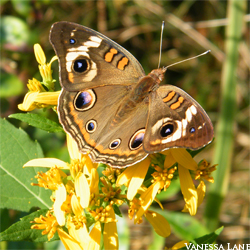 Habitat conservation is needed to preserve Georgia’s rich butterfly heritage because butterflies depend on certain plants during all four stages of their life cycle: egg, caterpillar, chrysalis and adult. Creating a butterfly garden in your backyard can provide such a habitat while being an exciting and rewarding project. These beautiful insects will add bright colors and many hours of enjoyment to your garden. Here are some simple steps to create a successful butterfly garden.
Habitat conservation is needed to preserve Georgia’s rich butterfly heritage because butterflies depend on certain plants during all four stages of their life cycle: egg, caterpillar, chrysalis and adult. Creating a butterfly garden in your backyard can provide such a habitat while being an exciting and rewarding project. These beautiful insects will add bright colors and many hours of enjoyment to your garden. Here are some simple steps to create a successful butterfly garden.
Plant your garden in the sun-Butterflies and most butterfly-attracting plants require bright sunshine.
Plant colorful nectar-producing flowers- Butterflies are first attracted to bright colored flowers, especially red, orange, yellow, pink and purple and then feed on the nectar of the flowers. Clusters of short, tubular flowers or flat-topped blooms provide the ideal shapes for butterflies to easily find, land, and feed. Examples of plants include lantana, verbena, milkweed, and yarrow.
Choose single over double flowers-The nectar of single flowers is more accessible and easier for butterflies to extract than the nectar of double flowers which have more petals per flower.
Plan for continuous bloom-Butterflies are active from early spring until late fall. Plant a selection of flowers that will provide nectar throughout the entire growing season.
Plant native host plants-To ensure butterflies will stay in your habitat, include native host plants in your garden. Many butterflies and native flowering plants depend on each other for survival and reproduction. Host plants provide butterflies with the nectar and foliage they need as caterpillars and adults. Examples of host plants include tulip poplar, hollyhock, and pawpaw.
Let them puddle-Butterflies often congregate around puddles of wet sand and mud to drink water and extract minerals. Create a butterfly puddle by placing a shallow pan with moist sand on the ground to collect rainwater.
Provide flat stones for rest- Flat stones provide space for butterflies to rest, spread their wings and bask in the sun. Basking raises their body temperature so they are able to fly and remain active.
Avoid pesticides-Most lawn pesticides, especially insecticides, are toxic to butterflies as well as many beneficial insects. Utilize predatory insects or use insecticidal soap instead.
Search for butterflies and wildflowers in your state: www.butterfliesandmoths.org/map and www.wildflower.org/collections
